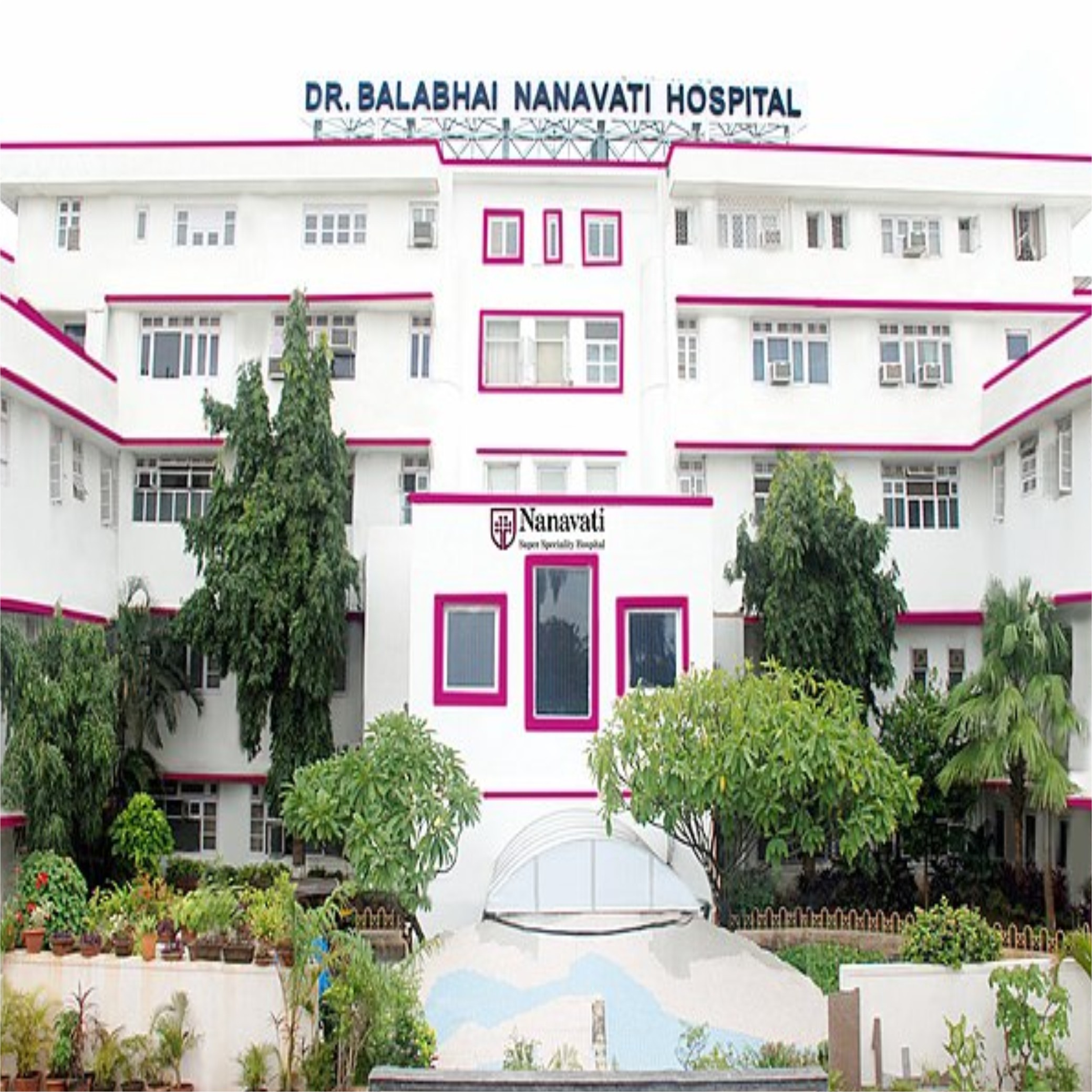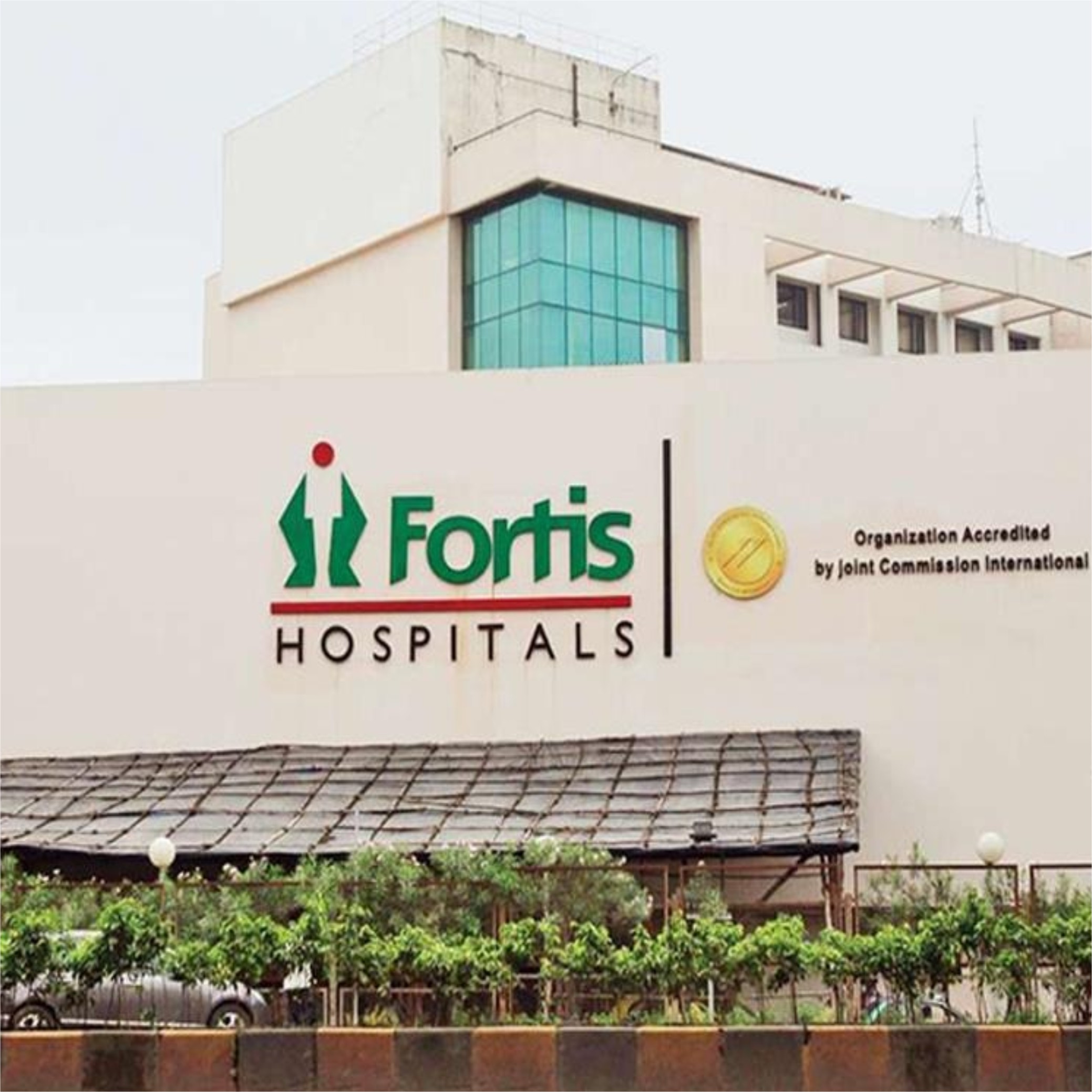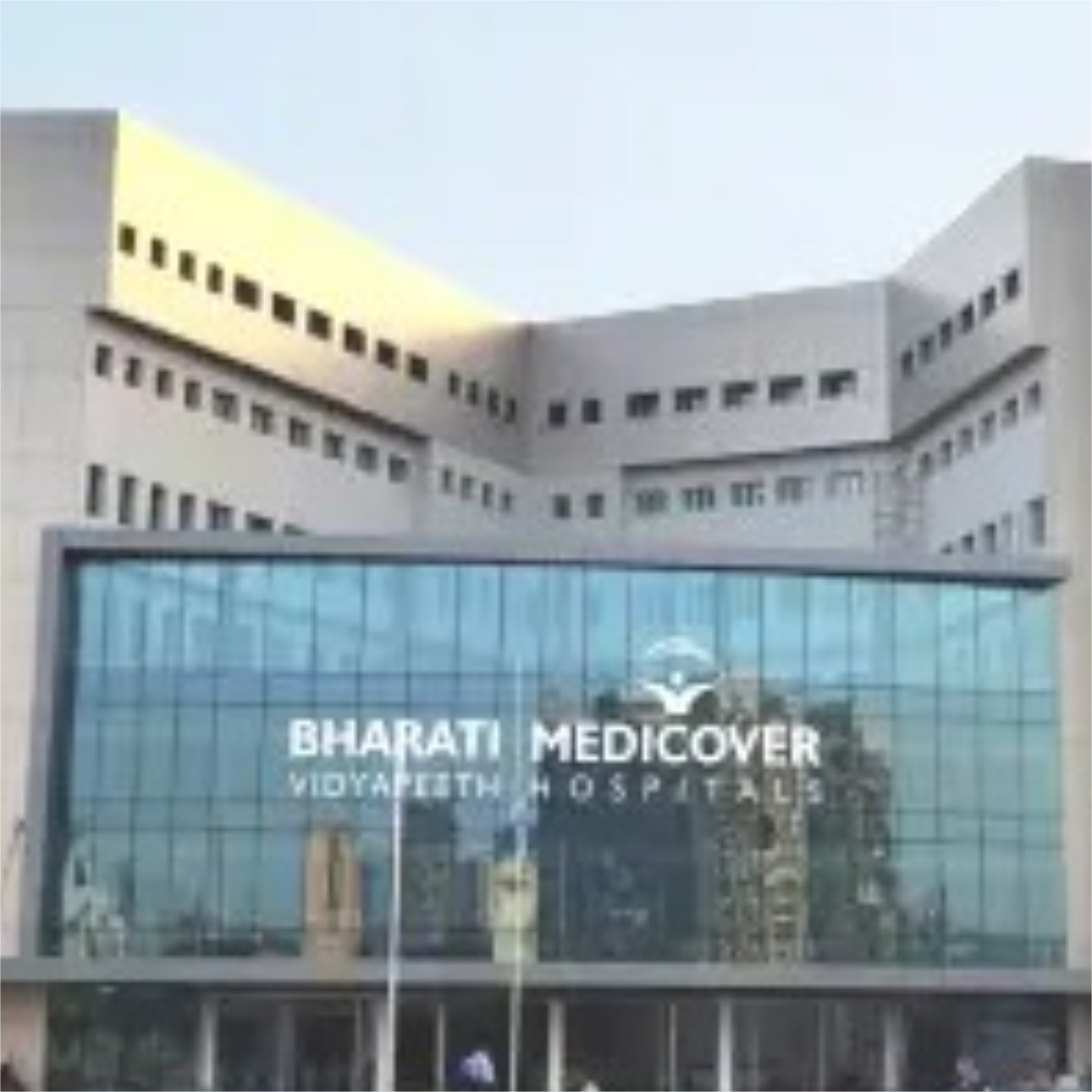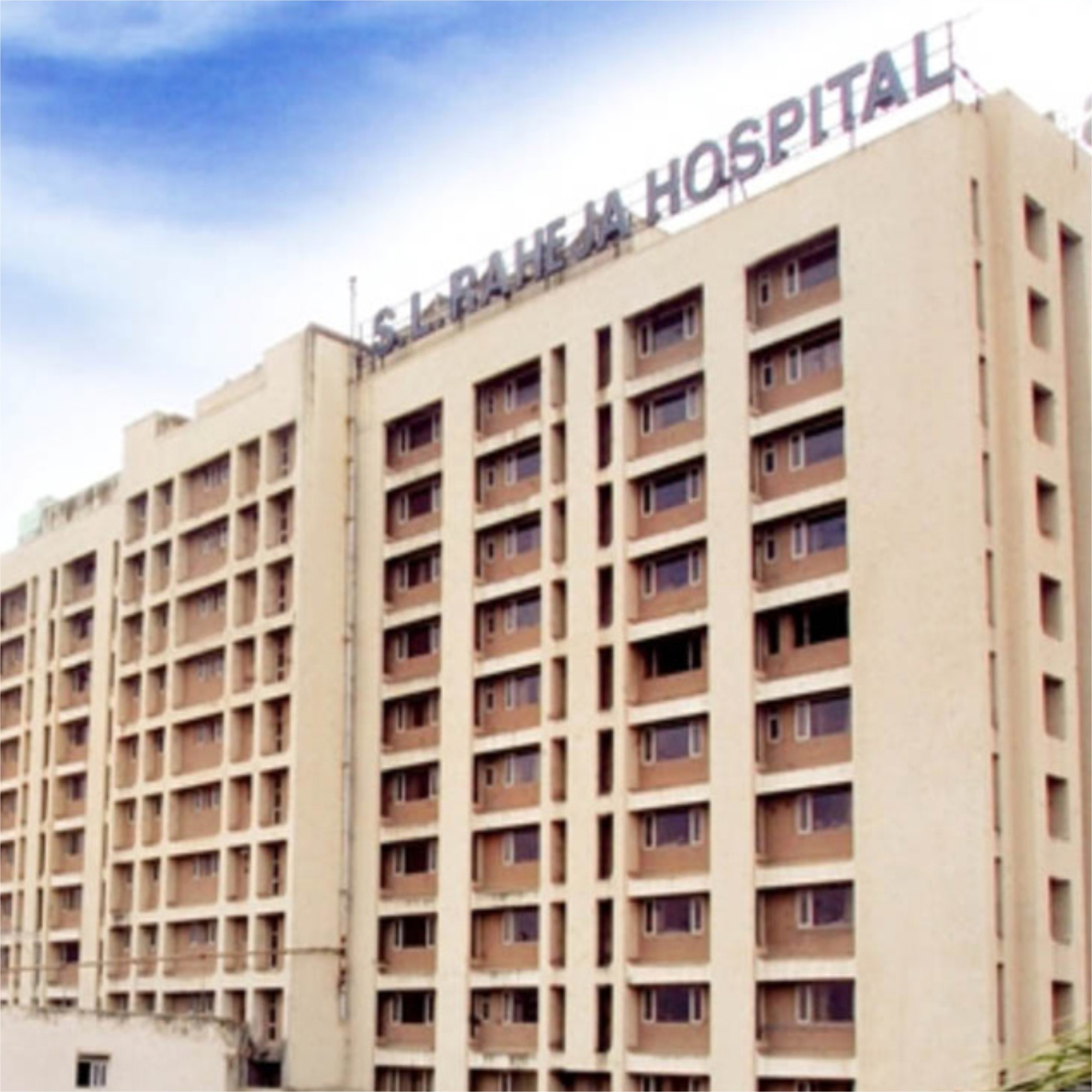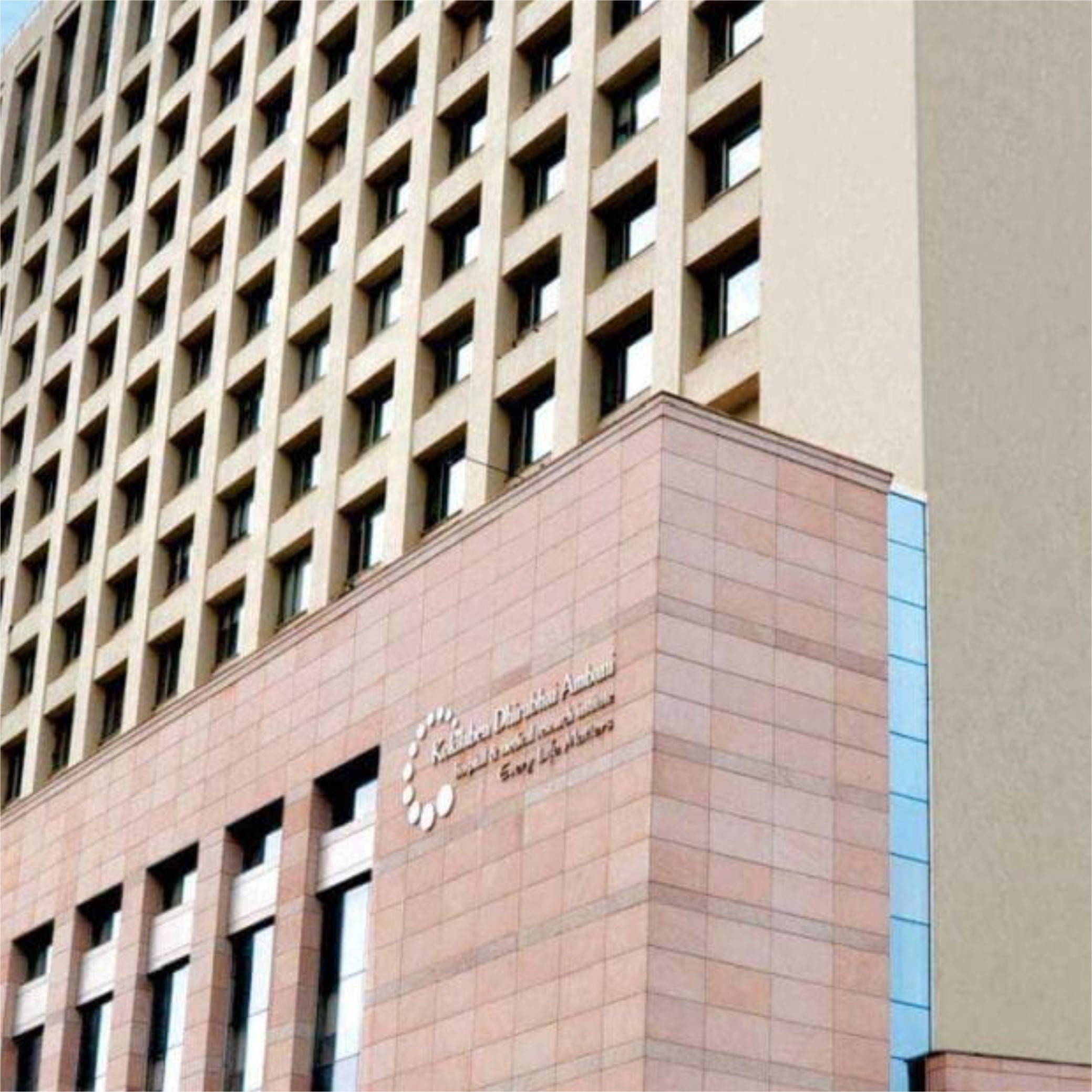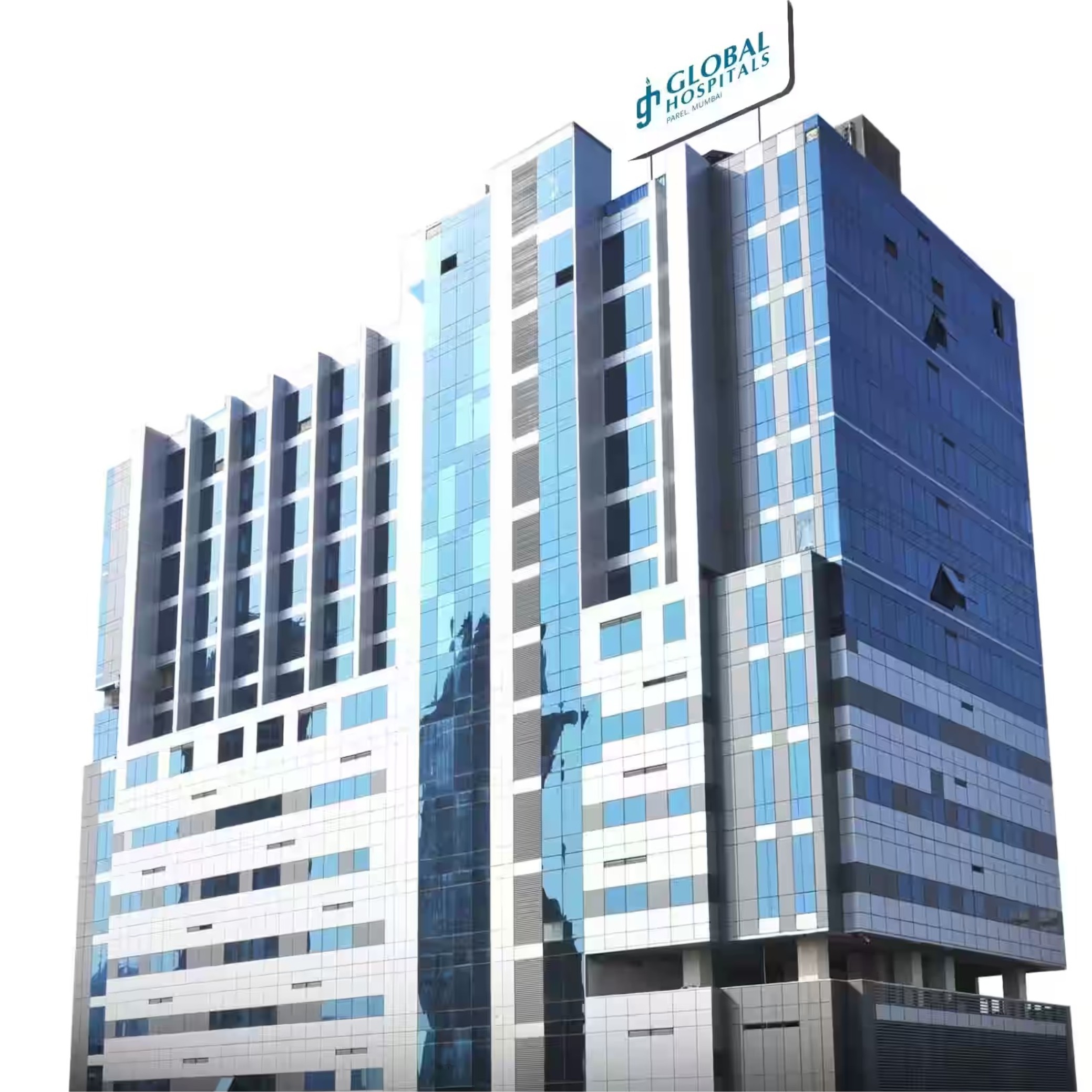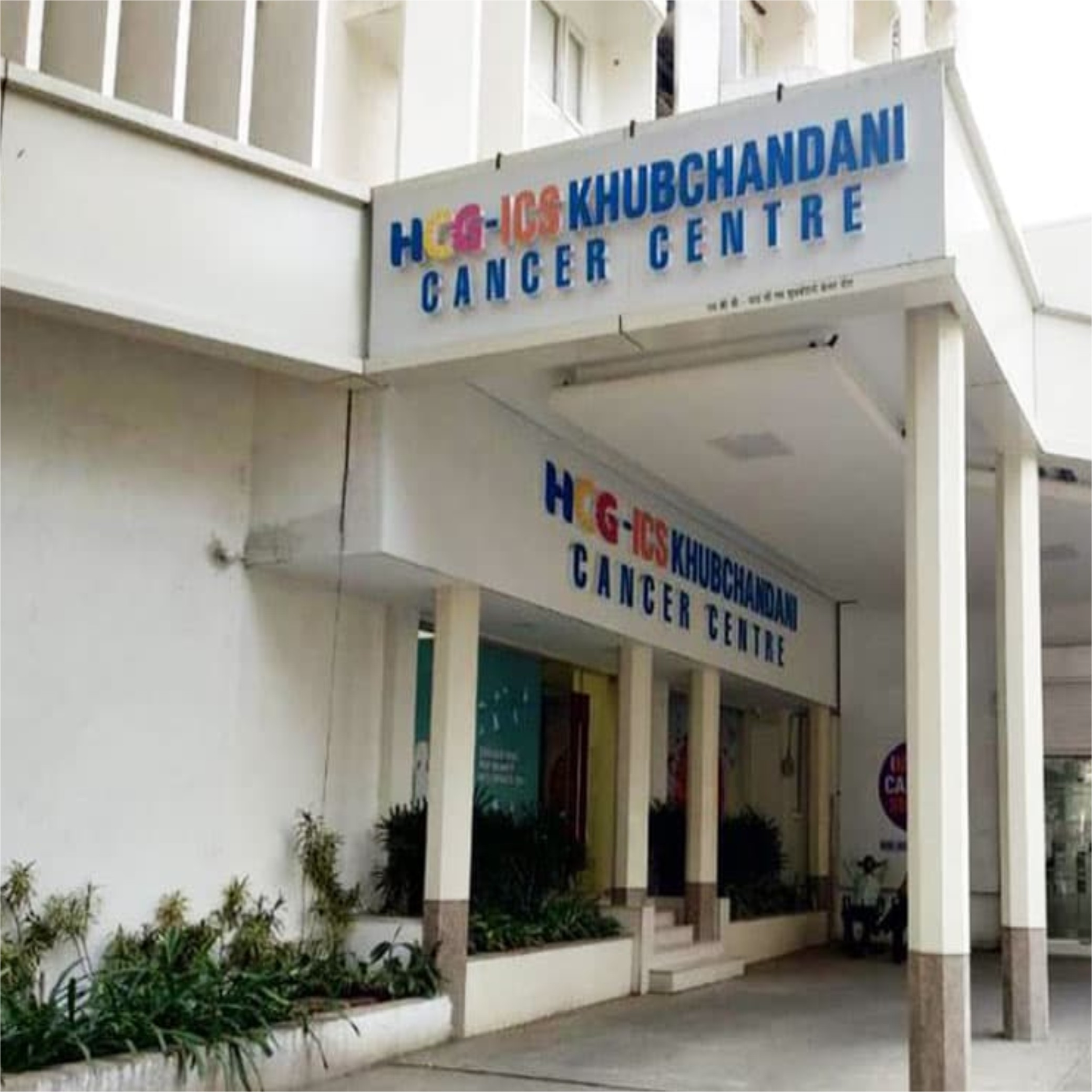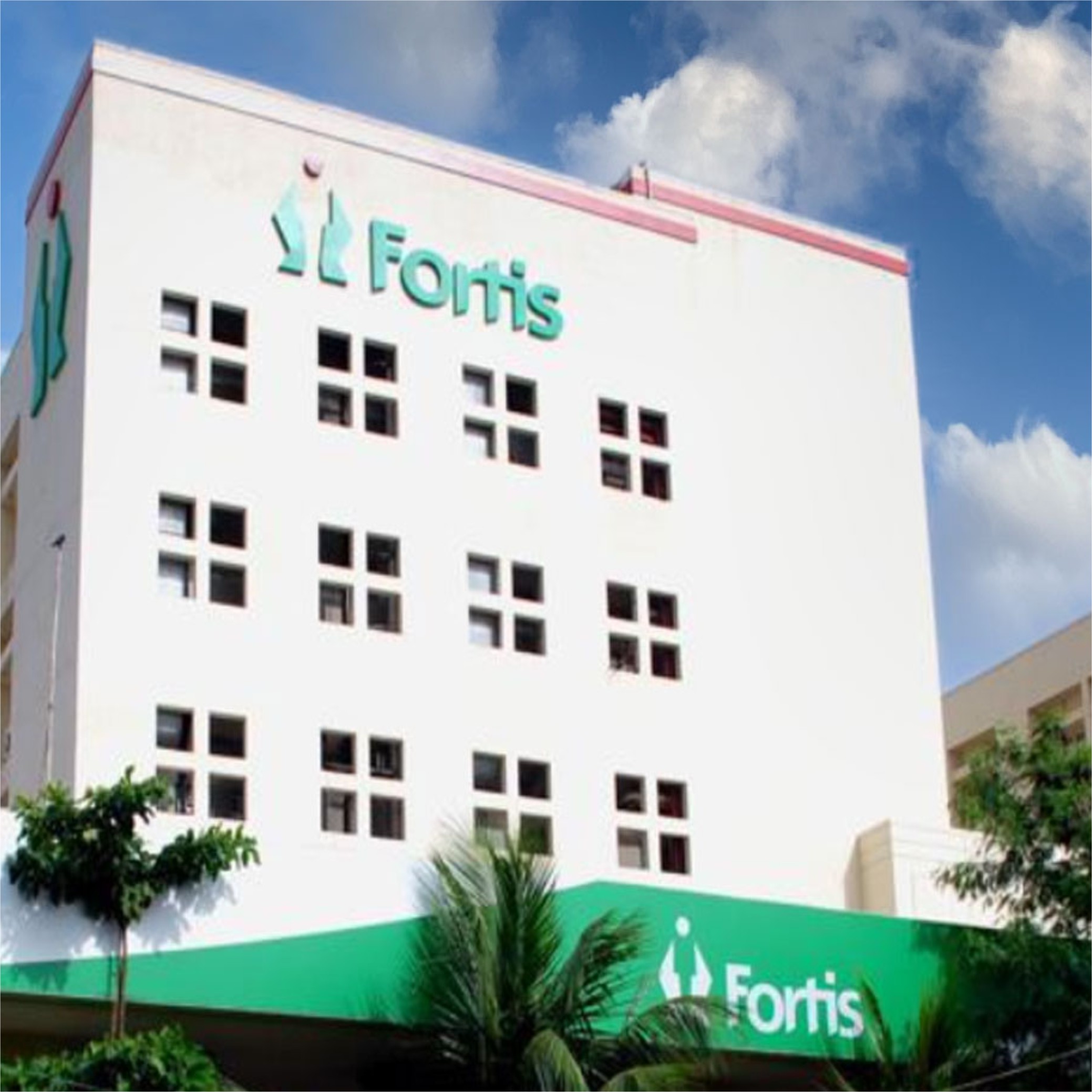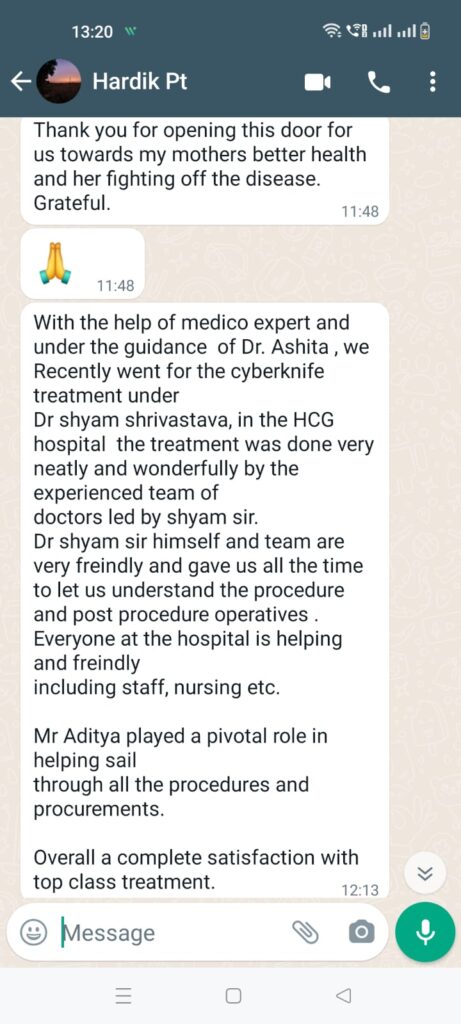Top class stereotactic radiosurgery in India
Do you know stereotactic radiosurgery (SRS) can save your life even when the tumor is present in such a critical position in the brain and spine where regular surgeries can’t be performed?
Stereotactic radiosurgery is a cutting-edge form of radiation therapy that delivers powerful and precisely targeted doses of radiation to small areas, effectively killing a small group of cells (tumor) without any surgery.
SRS can easily target multiple tumors deep in the brain and doesn’t have risks and complications of surgery. It is also known as a painless treatment.
This advancement in technology has given a ray of hope for all tumors that were inoperable and patients were not having options but to wait for an end. Today, 95% of brain tumors are treatable irrespective of their position either by minimally invasive surgery or by stereotactic radiosurgery or a combination of both.
Let’s understand from the experience of Jonty, from Accra, Ghana.
Jonty is a 44-year-old football coach in a reputed club. Jonty was married and has a very caring wife Christy.
Three years back, while Jonty was giving training to his team fainted and fell down, everything turned black. The team helped Jonty to come into consciousness and took him to the hospital for a checkup.


The doctor in the hospital did the physical examination and suggested Jonty do an MRI and blood test. As suggested Jonty did the test and the results of the MRI showed a tumor in the brain. Further tests confirmed it was a meningioma (a benign tumor) of 2 cm.
Jonty and his wife Christy were totally in shock after listening to the news. Jonty also consulted a few neurologists and neurosurgeons and they have suggested surgery is not possible because of the position of the tumor. The risk was too high. The meningioma was located very close to the brain stem.
Jonty’s best friend Sam suggested not to take any risk and visit India for the treatment. Sam forwarded MedicoExperts number to Jonty as Sam already visited India for her mother’s cancer treatment.
Christy contacted MedicoExperts and forwarded all the reports of Jonty. MedicoExperts team after receiving the reports arranged the online video consultation with the most experienced neurosurgeons from its panel. The neurosurgeons explained the risks of neurosurgery and also recommended the advanced technologies to treat brain tumors, stereotactic radiosurgery which is non-surgical radiation therapy. Jonty understood the treatment and decided to come to India for the treatment.
After 16 days, Jonty and Christy came to India for treatment, and Jonty was admitted to the hospital on the same day. Pre-evaluation tests were performed to check the current condition of the tumor. The reports were in favor to start the stereotactic gamma knife surgery. Gamma Knife surgery is a non-invasive, computer-assisted procedure that delivers highly focused radiation to brain tumors.
Jonty responded very well to the treatment and his tumor started shrinking. After a couple of months, the revaluation tests were performed. The test results indicated that the tumor has shrunk and not regrown.
Jonty and his wife Christy were very happy with the outcome of the treatment and thanked the doctor and MedicoExperts team.
This can be your story as well to win the battle against brain tumors even if you have a complex brain tumor at a very sensitive position. What you need is the right guidance, right treatment at the right time from the right experts.
Let’s understand what stereotactic radiosurgery is.
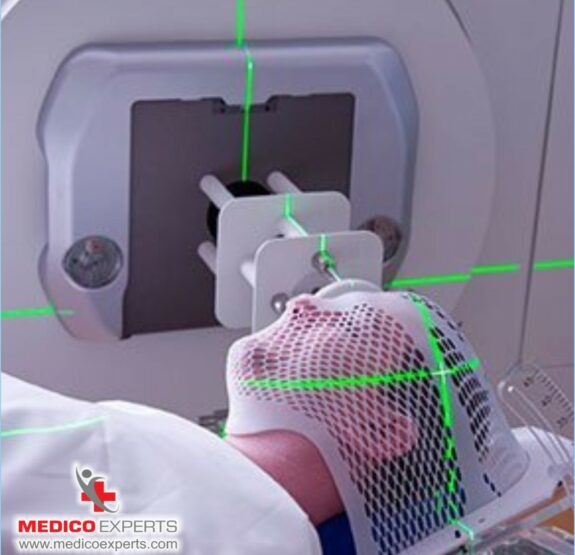
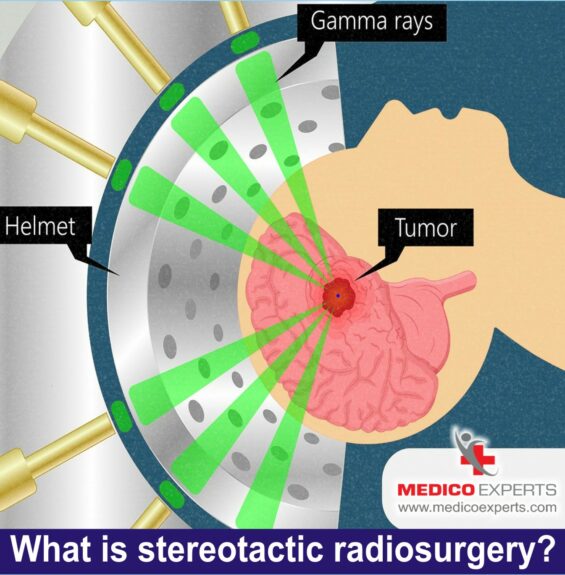
What is stereotactic radiosurgery?
Stereotactic radiosurgery is an innovative technology that enables doctors to treat various anomalies using radiation.
During stereotactic radiosurgery, X-ray beams are focused on the abnormal tissues through your skin. The precise exposure to X-rays distorts or destroys the DNA of abnormal cells by making them dormant or by initiating cell death.
The targeted focus of the X-ray radiation during radiosurgery ensures minimal damage to the healthy surrounding tissue. Also, with the help of stereotactic radiosurgery, your doctor reduces the risk of infection.
What are the different technologies that SRS - Stereotactic Radiosurgery depend on?
Stereotactic radiosurgery optimally uses highly advanced radiation technologies to destroy the target cells.
The different technologies on which Stereotactic radiosurgery depends include:
- Highly focused Gamma-ray or X-ray: The focused delivery helps to converge the radiation on the tumor or abnormal cells, thereby destroying them.
- Dedicated system: A dedicated system helps ensure proper positioning and immobilization of the patient during the procedure.
- 3D imaging and localizing technique: The 3D imaging technique helps your doctor determine the exact point of the targeted tumor.
- IGRT(Image Guided Radiation Therapy): IGRT enables your doctor to localize the tumor site using medical imaging techniques. Generally, tumor imaging is done before or during the procedure. Repeated imaging of the tumor helps improve the accuracy and precision of the treatment.
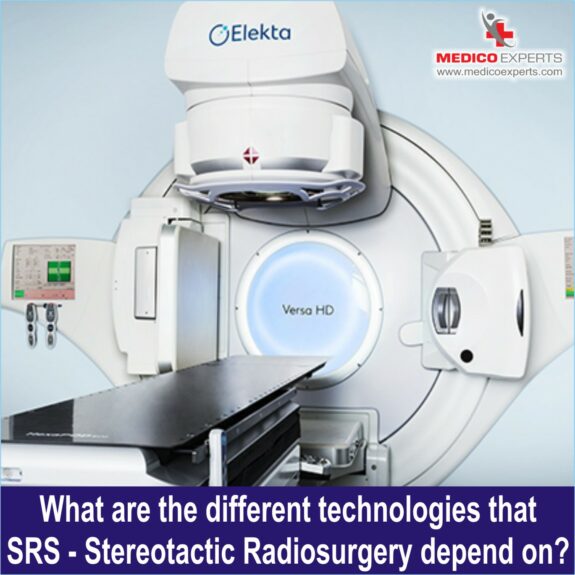
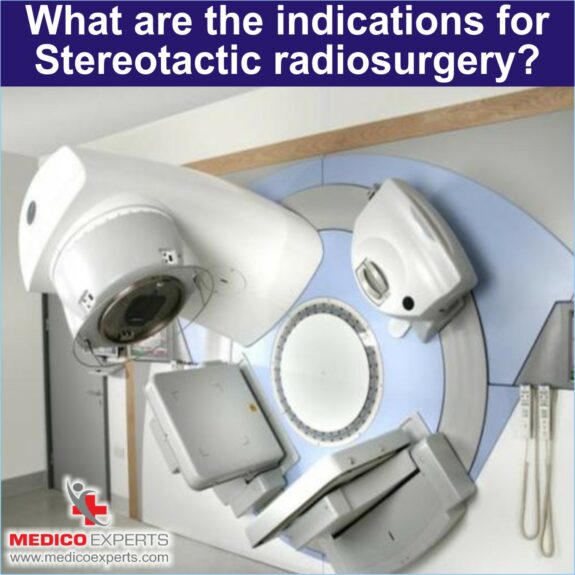
What are the indications for Stereotactic radiosurgery?
Stereotactic radiosurgery has emerged as a non-invasive and safe alternative to conventional treatment. This innovative approach is mainly advised for the patients having tumors but cannot undergo surgery, like:
- Tumor positioned in close approximation to vital body organs.
- Difficulty to reach the tumor
Stereotactic radiosurgery helps in treating:
- Brain Tumors like:
- Single, and multiple tumors in the brain and spinal cord
- Tumors developed in the intracranial, orbital, and at the base of the skull.
- If the tumor persists after the surgery or treatment
- Arteriovenous Malformations (AVMs)
- Neurological conditions like Trigeminal Neuralgia, Tremor, etc.
Stereotactic radiosurgery facilitates your doctor with surgical precision for treating small or difficult-to-reach abnormalities of the brain and spine. The targeted focus of the stereotactic radiosurgery reduces damage to healthy surrounding tissues.
What are the different types of stereotactic radiosurgery performed in India?
The different types of stereotactic radiosurgery techniques in India depend on the equipment used. Typically, there are two basic kinds of equipment used for stereotactic radiosurgery in India are:
Around 192 to 201 beams of highly focused gamma rays get targeted through a gamma knife. Gamma Knife radiosurgery technique is ideal for small to medium size lesions.
Gamma rays help manage malignant, and non-malignant tumors, without harming neighboring healthy tissue.
Gamma knife is used globally by doctors because of its ability to deliver the best results.
In a few people, the surgery alone is not sufficient to destroy the tumor cells entirely. Gamma knife radiosurgery helps such people to get rid of tumor cells completely.
A linear accelerator (LINAC) machine helps deliver high-energy x-rays or photons to the tumor. With the help of your LINAC machine, your doctor traces the tumor’s shape to initiate the death of the cancer cells. Tracing the tumor shape prevents exposure of the surrounding healthy cells to the powerful radiation rays.
The linear accelerator radiosurgery helps in treating larger tumors. Usually, these large tumors get treated in either a single or multiple sessions.
Fractionated stereotactic radiotherapy is a term coined for radiotherapy that requires multiple sessions to treat a tumor.
LINAC is popularly associated with famous brands like Novalis Tx™, XKnife™, and CyberKnife.
How is the procedure stereotactic radiosurgery performed in India?
The Gamma Knife radiosurgery usually comprises of four phases:
1. Placement of the head frame:
Before placing the head frame, your healthcare provider will insert a small needle in your hand or arm. The needle help administer medicine or contrast before the procedure.
Your neurosurgeon numbs your forehead and the back of your head before placing the headgear. Once numb, the doctor attaches a box-shaped head frame to your skull.
The head frame is a lightweight aluminum structure specially designed to avoid movement of the head during the treatment session. The head frame also guides the device to focus Gamma Knife beams at the treatment site.
2. Imaging of the tumor location:
Once the headgear gets fixed an MRI, CT scan or angiogram is performed based on the area for treatment. The MRI, CT scan, and angiogram help the Gamma Knife software pre-plan the treatment doses. A medical image taken before your treatment help improve the efficiency of the treatment process.
3. Computerized dose planning:
After getting the imaging done for the affected area, your doctors will ask you to wait until they identify the treatment for your ailment. This usually takes an hour or two.
4. Radiation delivery:
Once your doctor decides the treatment module, the treatment team will ask you to lie down on the Gamma Knife bed. Thereafter, the team will attach the head frame to your head. The team will fix the head frame to the machine before starting the treatment.
Once you are comfortable, the treatment team will begin your treatment. Throughout, the treatment, you will be able to talk to your doctor through a microphone attached to your helmet.
Once you are ready, the bed on which, you are lying is pushed behind.
The treatment usually finishes within a few hours. Once the treatment gets over, the team removes the head frame, and you can go home.
The Linear accelerator (LINAC) radiosurgery uses a similar procedure as the Gamma Knife radiosurgery. The four phases include:
1. Headframe placement:
Your healthcare provider will insert a small needle in your hand or arm before placing the headframe. The needle help administer medicines and contrast into the body for contrast for imaging.
After inserting the contrast, your neurosurgeon numbs your forehead and the back of your head to attach the head frame.
The head frame is a lightweight aluminum structure specially designed to avoid movement of the head during the treatment session. The head frame helps guide linear accelerator beams to focus at the treatment site.
2. Imaging:
Once the headgear gets fixed, an MRI, CT scan, or angiogram is performed. The MRI, CT scan, or angiogram helps the linear accelerator software in pre-planning. Medical imaging, taken before the treatment, helps improve the efficiency of the treatment process.
3. Computerized dose planning:
Once the imaging is done, the team of your doctors will identify the best treatment for your condition.
4. Radiation delivery:
LINAC technology is a popular radiosurgery approach. Unlike, Gamma Knife technology, the LINAC machine rotates continuously around the patient while delivering the radiation beams from different angles.
Thereby, helping in treating large tumors or tumors that are difficult to reach.
Who is eligible to undergo radiosurgery treatment in India?
While radiosurgery is a non-invasive and comparatively safe procedure, not everyone can undergo it. You can be a suitable candidate for radiosurgery, if:
- There is a neurological condition/tumor which cannot get accessed surgically
- Your doctor was unable to remove the tumor through surgery.
- If you do not wish to undergo a surgical procedure.
- There is a recurrence or regrowth of the tumor.
- Your doctor has shown concerns about you getting administered anesthesia.
- You can not undergo surgery due to underlying comorbidity.
- If you have undergone, any treatment and you still need additional treatment.
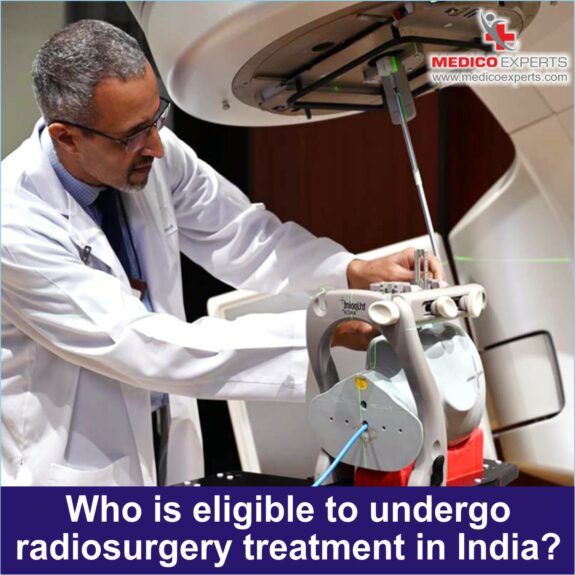
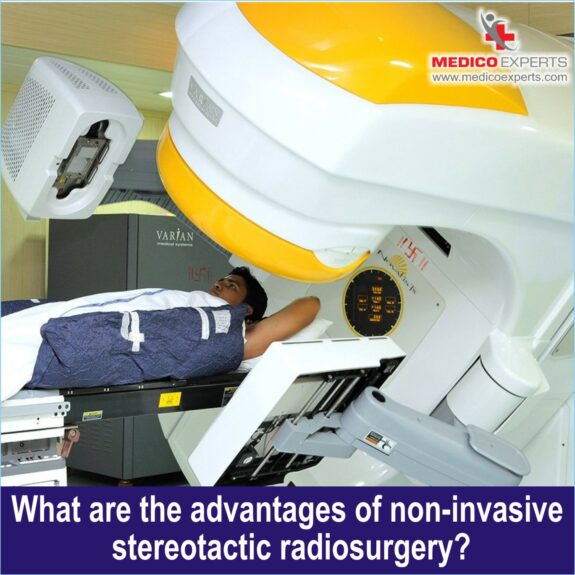
What are the advantages of non-invasive stereotactic radiosurgery?
Studies suggest that non-invasive radiosurgery is a safe procedure that effectively helps to treat tumors of the brain and spine, atrioventricular conditions, and other nerve ailments. The advantages of non-invasive radiosurgery technique over conventional treatment are:
- Reduced damage to the surrounding muscles and neighboring healthy tissues.
- Minimal pain
- Minimal scarring.
- Reduced risk of infection
- Reduced recovery time
- Reduced rehabilitation time
How to choose the best neurosurgeon/radiologist for your stereotactic radiosurgery?
If you’re considering stereotactic radiosurgery in India, you must choose a neurosurgeon/radiologist carefully, and thoughtfully. You must ensure that your doctor (radiologist/neurosurgeon) must have a precise and methodical approach in everything he/she does.
Also, you must ensure that they communicate with you in a way that makes you feel comfortable and confident about their skills and their plan of action.
Well, the best way to ascertain the best neurosurgeon/radiologist who is the best fit for you include:
- Is your doctor board-certified in their specialty?
- Did your doctor carefully attend to your concerns and your case history?
- If your doctor conducted a detailed neurological/radiological exam focused on your specific complaint?
- Did your doctor take time to educate you about your condition and upcoming procedure?
If the answers are yes then your doctor is a good neurosurgeon/radiologist for you.


How to choose the best hospital and the best country for stereotactic radiosurgery in India?
The non-invasive stereotactic radiosurgery involves cutting-edge technology that has emerged as a safe alternative to conventional treatment. Stereotactic radiosurgery requires advanced technology, precise imaging techniques, and well-trained healthcare staff.
While choosing a hospital for stereotactic radiosurgery, search for a NABH and JCI certified hospital. Also, ensure that the hospital offers world-class healthcare services and is equipped with the latest devices.
Although the UK and USA have advanced hospitals that offer advanced stereotactic radiosurgery hospitals, the treatment in western countries may be a bit expensive.
Unlike any western nations or other developed nations, the cost of stereotactic radiosurgery in India is almost half.
The access to world-class treatment at pocket-friendly prices has attracted many multinational citizens to India for their treatment.
Apart from affordable prices and world-class facilities, the availability of well-trained doctors and healthcare staff also attracts many foreign nationals to India.
The Indian healthcare system boasts of well-trained neurosurgeons/radiologists, operative and post-operative care teams who are capable of handling complex cases.
What is the cost of non-invasive stereotactic radiosurgery in India?
Non-invasive stereotactic radiosurgery is a revolutionary surgical approach to treat tumors, atrioventricular diseases, and other nerve disorders. But have you ever wondered about the cost of stereotactic radiosurgery in India?
Typically, stereotactic radiosurgery costs around USD 5,800 – USD 8,000 in India (439178 – 605764 INR).
However, the cost for stereotactic radiosurgery varies for every patient depending on various factors.
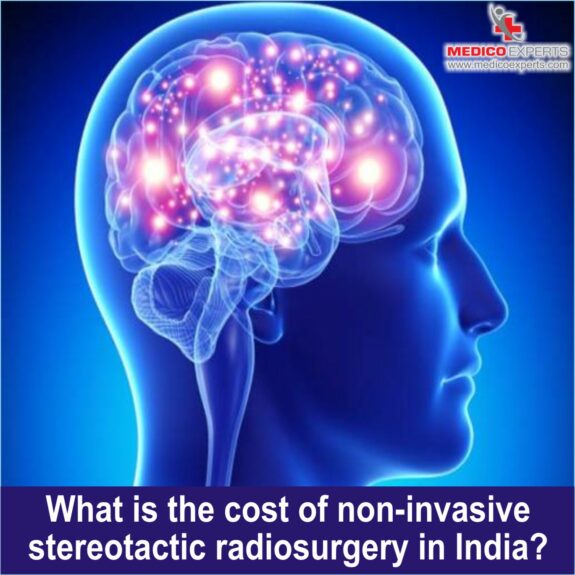
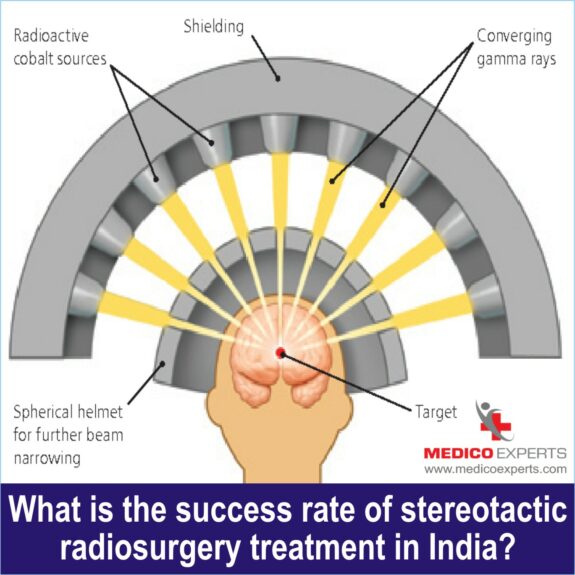
What is the success rate of stereotactic radiosurgery treatment in India?
The average success rate for stereotactic radiosurgery treatment in India is about, 95.5%.
Benign tumors generally shrink over 18 months to two years.
However, it only takes a few months to shrink malignant cancerous tumors.
While the treatment for atrioventricular conditions may take around 2 years or sometimes even more.
Frequently Asked Questions and patient concerns:
1. Do I need to get admitted for stereotactic radiosurgery?
Typically, stereotactic radiosurgery is an outpatient procedure. However, sometimes you might be required to stay in the hospital so that your doctor can monitor your vitals.
2. What are the side effects of stereotactic radiosurgery?
Sometimes a few people may experience the following side effects after undergoing stereotactic radiosurgery:
- Damage to the healthy surrounding tissue
- Headache
- Brain swelling
- The skin at the site of treatment may become itchy or sensitive
- Severe hair fall
- Persistent nausea, sometimes vomiting too.
- Difficulty in swallowing food and drinks
- Loose stool
- Loss of appetite
- Fatigue
3. Can I drive back home from the hospital after stereotactic radiosurgery?
Although stereotactic radiosurgery is an outpatient procedure still people who underwent this procedure should not drive home soon after the procedure. You must arrange for someone to drive you back home.
4. What care should I take before undergoing stereotactic radiosurgery?
Before undergoing stereotactic radiosurgery, you must ensure:
- To get an MRI, CT scan, or angiography was done.
- Avoid applying any hair spray or cream on the day of the procedure
- Remove any jewelry you might be wearing before undergoing the procedure.
Best Stereotactic Radiosurgery Hospitals in India

MedicoExperts is a Global virtual hospital which is established to offer quality healthcare services at affordable pricing without compromising the success rates of the treatment.
MedicoExperts is having a network of highly experienced super specialist doctors and well equipped hospitals across the globe and offering second opinion through online video consultation and surgical interventions through its empanelled super specialist doctors at its network hospitals in 17 countries from 3 continents.
By the virtue of its approach and model, MedicoExperts is successfully achieve to deliver
- Latest and most advanced treatments with success rates of international benchmarks.
- Multiple cost options depending upon the hospital facilities, with the same doctor.
- Treatment option in multiple cities/state/countries.
- Trust and peace of mind.
Most suitable for patients who are looking for:-
- Planned Surgeries and treatment from most experienced doctors and at multiple cost options as per hospital facilities with best possible outcomes.
- Second Opinion from expert doctors.
- Complex cases involving multi specialities
- International patients looking for treatment from Indian doctors

Author Bio:
Dr. Ashita Nandgaonkar – BHMS, MS in psychological counseling
Dr. Ashita Nandgaonkar is a highly esteemed homeopathic doctor with a passion for holistic healing and patient-centered care. Dr. Nandgaonkar remains dedicated to raising awareness about the benefits of homeopathy and promoting its integration into mainstream healthcare. Her mission is to empower individuals on their journey to health and wellness, embracing the holistic approach that homeopathy offers. She has a special interest in researching Homeopathic solutions for diseases that are difficult to treat with conventional medicines and therapies.
Content Medically Reviewed By MedicoExperts Editorial & Clinically Review Board








